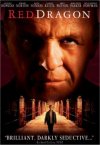BUY THE DVD:
|


|
|
|
SYNOPSIS:
| |
fbi agent will graham seeks the help of dr. hannibal "the cannibal" lecter to help solve the case of "the tooth fairy."
|
|
|
MOVIE FACT:
| |
ralph fiennes' back tattoo took 8 hours to apply.
|
|
|
RATING:
|


two out of four possible stars
|
|
|
|
While it might be easy to compare this film to its original, 1986's Manhunter, and a be a breeze to list its likenesses and differences to Silence of the Lambs and Hannibal, the fact would remain that Red Dragon, as a thriller, stands on some wobbly legs, but stands on its own nonetheless. Director Brett Ratner hasn't brought anything new to the Hannibal Lector biography, but the cast that surrounds Anthony Hopkins' precise performance lives up to expectations.
While the hype that this film is the "most terrifying installment of the Hannibal Lector trilogy," is certainly a mislead, the movie is more successful in creating interesting characters to look at, rather than in creating pure horror. The byplay between the actors is quite fascinating to watch and if not for a stellar cast, this film would look more like Hannibal than Silence of the Lambs. It is rare that a sequel is so different from its predecessor, and Hannibal definitely did not pay homage to the masterpiece that came before it.
Red Dragon, on the other hand, would best be described as a combination of standard sequel techniques with some fortunate glimpses of the first film. The actual mental hospital set from Silence of the Lambs, or one that matched the original quite well, was used for some of the scenes between Edward Norton's FBI character and Hopkins, and the results made for some of the best interaction in the film. Never mind the instances when people are getting knifed, shot, bitten, or drugged. The real value in this film comes from Norton, Hopkins, and their co-stars.
In an role that is quite a departure from many of his past roles, Ralph Fiennes plays a good wack-job. He gives his serial killer character of "Francis Dolarhyde" an interesting characteristic in that the audience will not feel only hatred toward him after the film ends. Although he is guilty of several gruesome murders, his character is tortured enough mentally to elicit some empathy from the audience. Which is quite a feat, given his crimes. This empathy is generated in part from a more than solid performance from Emily Watson, who plays Fiennes' girlfriend.
It is particularly ironic that Watson's character is a blind woman who cannot see the monster to which she's attached herself. Like Fiennes, Watson includes small physical gestures into her performance that make her seem all the more convincing in her role. And while we're on the subject of being convincing, Fiennes and Watson both pull off the American accents quite well. Whereas Hopkins' slightly Anglicized Lector adds to the mystery of his genius, Fiennes and Watson benefited from a talented dialogue coach.
Philip Seymour Hoffman cements his credibility as being one of the strangest actors in Hollywood by taking the role of the slimy tabloid reporter, "Freddy Lounds." Although he doesn't get a lot of screen time, Hoffman still makes an impression, as he does in all of his off-kilter roles. Harvey Keitel, also makes a solid appearance in the film, though there is nothing magical about his performance. Probably the only underused character of the film, as there are several characters which have bearing on the story of Red Dragon, was Mary Louise Parker.
It should be considered a crime in Hollywood to introduce such a strong character in the beginning of the film and then not feature her again until the closing sequence. Parker's talent comes like a slap in the face her last scene and it's a shame she wasn't featured as a larger player. But her lack of screen time is probably the result of how the film was edited and written. Perhaps it was impossible for the filmmakers to realize how much Parker would bring to the movie in her few moments. The screenplay could be considered standard, if nothing else, though there are two problems which creep up around the halfway point.
Approximately one hour into the film, the tension that the movie set up in the first act dissipates somewhat. While there are some nail-biting moments throughout the second half, the shocks delivered to the audience become less impressive as the film wears on. And the plot of the film is unforgivably predictable in its last fifteen minutes. Good performances aside, the film plays like a well-read book for anyone who's seen a suspense thriller before. Perhaps the filmmakers were attempting to keep the film as close to the novel as possible, but it seems they could have thought up some more unique twists and turns in the film without offending too harshly fans of the novel.
When the FBI agents raid the house they believe is the home of the serial killer in the third act of Silence of the Lambs, the twist built into the film's editing is a genius bait and switch. But Red Dragon, in contrast, must rely too much on its heavy soundtrack to scare its audience sufficiently. But despite these failings in story and the heavy handed score, Red Dragon still packs more punch than Hannibal, and is a more worthy sequel to Lambs. Audiences have been fascinated with the character of Hannibal Lector for years and with good reason. Anthony Hopkins gives a dead on performance and whenever he is on the screen, the audience will probably cease to blink.
Review by Kelsey Wyatt.
| |
|